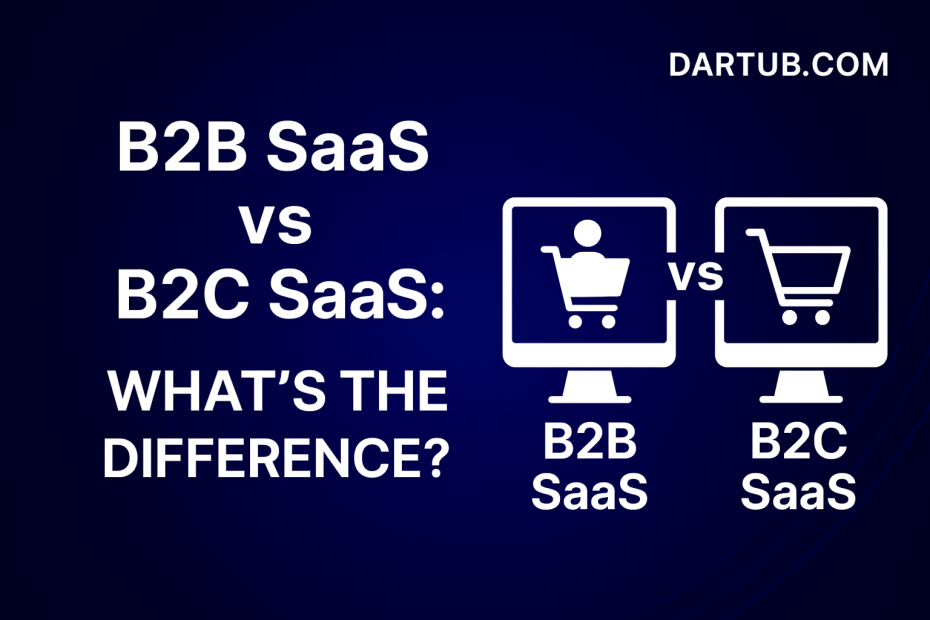In today’s rapidly growing software landscape, SaaS (Software as a Service) dominates as the preferred model for delivering software over the internet. But within the SaaS world, there are two very distinct categories: B2B SaaS (Business-to-Business) and B2C SaaS (Business-to-Consumer).
Though both leverage subscription-based models, the target audience, marketing strategy, pricing, sales cycle, and product design vary greatly. Understanding these differences is key to building the right strategy for your SaaS product.
In this detailed guide, we’ll break down the key distinctions between B2B SaaS vs B2C SaaS and explore which model might be right for your business.
What is B2B SaaS?
B2B SaaS refers to software products designed to serve other businesses rather than individual consumers. These solutions typically aim to streamline operations, improve efficiency, manage workflows, or help teams collaborate.
Key Characteristics of B2B SaaS
- Target Audience: Companies, teams, professionals
- Sales Cycle: Longer, multi-stakeholder buying process
- Pricing: Higher, often annual contracts
- Support: Personalized onboarding, dedicated support teams
- Customization: Integrations, advanced settings, APIs
Example B2B SaaS Products
- Salesforce (CRM)
- HubSpot (Marketing automation)
- Slack (Team communication)
- Zoom (Video conferencing for business)
- Monday.com (Project management)
What is B2C SaaS?
B2C SaaS products are targeted at individual consumers rather than businesses. These apps are typically easy to use, affordable, and solve personal or lifestyle needs.
Key Characteristics of B2C SaaS
- Target Audience: Individual users, consumers
- Sales Cycle: Short, impulsive buying behavior
- Pricing: Low, freemium or monthly subscriptions
- Support: Self-service FAQs, community forums
- Customization: Minimal, focused on usability
Example B2C SaaS Products
- Netflix (Streaming)
- Spotify (Music streaming)
- Grammarly (Writing assistant)
- Canva (Design tool)
- Dropbox (Cloud storage)
B2B SaaS vs B2C SaaS: Core Differences
| Aspect | B2B SaaS | B2C SaaS |
|---|---|---|
| Target Audience | Businesses, teams | Individual consumers |
| Sales Cycle | Long, complex | Short, transactional |
| Pricing | High-ticket, annual contracts | Low-ticket, monthly or freemium |
| Product Complexity | Advanced features, integrations | Simple and user-friendly |
| Support | High-touch, account management | Self-service, community-based |
| Marketing Focus | Relationship-driven, ABM | Viral growth, mass marketing |
| Customer Churn | Low | High |
| Revenue Model | High LTV per customer | High volume, low ARPU |
Sales & Marketing Strategy
B2B SaaS Sales & Marketing
- Account-Based Marketing (ABM)
- Personalized outreach to decision-makers
- Demos, consultations, enterprise sales
- Long sales cycles (weeks to months)
- Heavy emphasis on content marketing (case studies, whitepapers)
B2C SaaS Sales & Marketing
- Product-led growth (PLG)
- Viral marketing, influencer campaigns
- Freemium to paid conversion funnels
- Paid acquisition (Google Ads, social ads)
- SEO and app store optimization
Pricing Model
B2B SaaS Pricing
- Tiered pricing based on features/users
- Annual contracts common
- Enterprise pricing for large customers
- Incentives for long-term commitment
B2C SaaS Pricing
- Monthly subscriptions
- Freemium with premium upsells
- In-app purchases
- Discounts for annual prepay
Product Design Philosophy
B2B SaaS Design
- Focused on functionality and scalability
- Multi-user collaboration
- Advanced reporting and analytics
- Integration with third-party tools
- Security and compliance features
B2C SaaS Design
- Simplicity and usability is key
- Mobile-first design
- Engaging, visually appealing UI
- Personalized experiences
- Easy onboarding
Support & Customer Success
B2B SaaS Support
- Dedicated account managers
- Onboarding programs
- SLA guarantees
- 24/7 priority support for enterprise clients
B2C SaaS Support
- Help centers and FAQ libraries
- Community forums
- Chatbots and automated responses
- Minimal human support (cost-efficient)
Revenue Model
B2B SaaS Revenue Model
- Annual Recurring Revenue (ARR) focus
- Lower volume, higher contract value
- Upselling to larger packages
- Low churn, long-term customer relationships
B2C SaaS Revenue Model
- Monthly Recurring Revenue (MRR) focus
- High volume, low per-user revenue
- Conversion optimization is key
- High churn; ongoing acquisition needed
Example Companies
Top B2B SaaS Companies
- Salesforce
- Zoom (Enterprise)
- Slack
- Atlassian (Jira, Confluence)
- HubSpot
Top B2C SaaS Companies
- Spotify
- Netflix
- Canva
- Grammarly
- Dropbox
Conclusion: Which Model is Right for You?
Choosing between B2B SaaS and B2C SaaS depends on several factors:
- Audience: Are you serving businesses or individual consumers?
- Product complexity: Is your product a simple app or an enterprise solution?
- Sales & marketing: Are you prepared for long sales cycles or fast-paced growth?
- Revenue goals: Do you prefer fewer high-paying clients or a large volume of customers?
Summary:
- B2B SaaS: High LTV, longer sales cycles, deeper relationships, complex products
- B2C SaaS: High volume, short sales cycles, mass marketing, simple UX-first products
Both models can build successful, scalable businesses — the key is aligning your strategy with your product and audience.
Final Verdict
- If you’re building enterprise-grade software with complex features, B2B SaaS is your play.
- If you want to create consumer-friendly apps with viral growth potential, B2C SaaS is the way to go.
Understanding these differences will help you craft a winning strategy and avoid common pitfalls as you scale your SaaS business.
